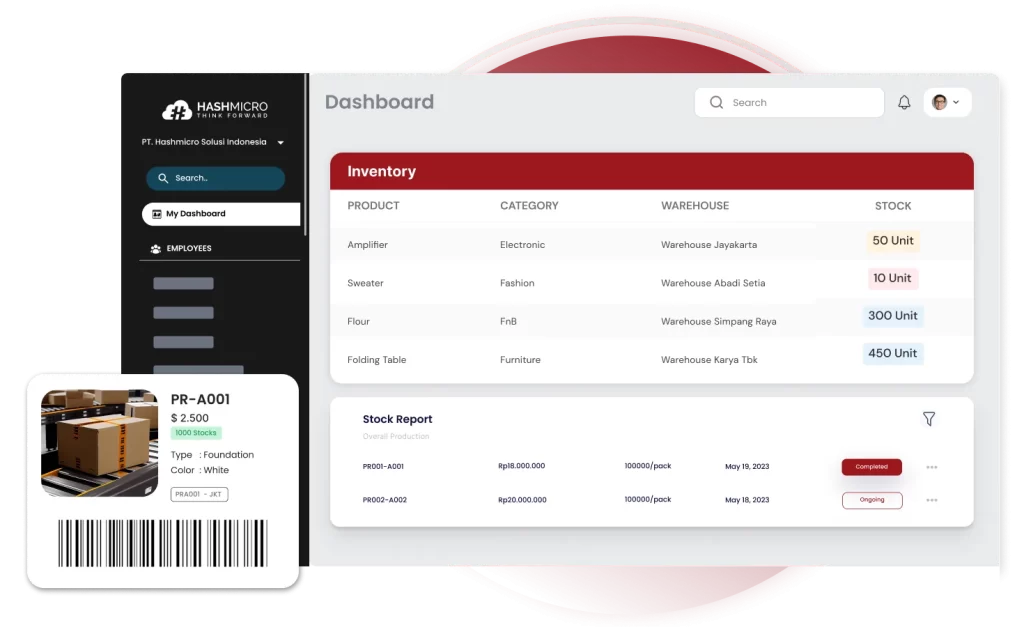Do you know if your stock levels are accurate? Are you worried about running out of products or overstocking? Managing finished goods inventory can be daunting. Small mistakes in inventory tracking can lead to disruptions, waste, or lost sales.
The finished goods inventory formula helps businesses maintain an ideal balance between production and sales. By accurately calculating stock, companies can avoid both shortages and excess inventory. This calculation is essential for smooth operations and meeting customer demand without unnecessary costs.
In this article, we’ll guide you through the step-by-step process of calculating finished goods inventory. We’ll break down each formula part and explain how to apply it in business. By the end, you’ll have a clearer understanding of how to keep your inventory levels optimized.
Key Takeaways
|
What is Finished Goods Inventory?
Finished goods inventory refers to products that are fully manufactured, packaged, and ready for sale or distribution. These goods have gone through all stages of production and are now waiting to be sold to customers or shipped to retailers.
Managing finished goods inventory is crucial for maintaining operational efficiency in a business context. It ensures that companies have enough stock to meet customer demand without overproducing, which can tie up resources.
To calculate finished goods inventory, businesses track the flow of products from production to storage. Understanding what is finished goods inventory formula helps in determining the value of goods ready for sale, allowing businesses to assess their financial health and inventory turnover.
Now that we understand the concept, let’s explore why managing finished goods inventory is so important.
The Importance of Finished Goods Inventory Management

Inventory management of finished goods is crucial in a company’s ability to meet customer demand while controlling costs. Proper inventory practices ensure products are available when needed, helping to avoid stockouts or overstocking, which can lead to lost sales or unnecessary storage expenses.
Businesses can boost cash flow and minimize waste by closely tracking finished goods inventory. This enables more accurate demand forecasting, better production planning, and help maintain the right balance between supply and demand.
Managing finished goods inventory effectively also improves overall supply chain efficiency. It fosters better coordination among production, sales, and distribution teams, which leads to quicker order fulfilment and higher customer satisfaction.
How to Calculate Finished Goods Inventory
Calculating finished goods inventory involves three main components: the beginning inventory, cost of goods manufactured (COGM), and cost of goods sold (COGS). Understanding these components will help businesses track their stock effectively.
1. Identify beginning finished goods inventory
The first step is determining the finished goods inventory at the start of the period, usually found on the previous period’s balance sheet. This represents the inventory available for sale at the beginning of the current period.
2. Add Cost of Goods Manufactured (COGM)
Next, add the Cost of Goods Manufactured (COGM), the total cost incurred to produce finished goods during the period. This includes direct materials, direct labour, and manufacturing overhead.
Formula
COGM = Total Manufacturing Costs + Beginning Work-in-Progress Inventory – Ending Work-in-Progress Inventory
3. Subtract Cost of Goods Sold (COGS)
Finally, subtract the Cost of Goods Sold (COGS), which is the total cost of goods sold during the period. This includes the materials, labour, and overhead costs for the goods sold.
By following these steps, businesses can ensure their finished goods inventory remains accurate and well-managed. Let’s look at an example to see how this works in practice.
Related Article: Work in Process Inventory: Key Insights for Businesses
Example Format for Finished Goods Inventory Tracking
![]()
Tracking finished goods inventory helps businesses keep track of products that are ready to sell but haven’t been sold yet. Here’s an simple of how this tracking can be structured:
| Month | Starting Inventory ($) | Made This Month ($) | Sold This Month ($) | Ending Inventory ($) |
| January | 15,000 | 50,000 | 40,000 | 25,000 |
| February | 25,000 | 40,000 | 30,000 | 35,000 |
| March | 35,000 | 60,000 | 50,000 | 45,000 |
| April | 45,000 | 30,000 | 20,000 | 55,000 |
Columns Explained:
- Month: The month you are tracking the inventory for.
- Starting Inventory: The value of the finished goods at the start of the month (from the previous month).
- Made This Month: The total cost of the goods produced during the month.
- Sold This Month: The total cost of the goods sold during the month.
- Ending Inventory: The remaining value of finished goods at the end of the month. You calculate it using the ending inventory formula like this:
Ending Inventory = Starting Inventory + Made This Month − Sold This Month
Example Calculation:
Let’s say we’re looking at January:
- Starting Inventory (Jan 1) = $15,000
- Made This Month (January) = $50,000
- Sold This Month (January) = $40,000
To find the Ending Inventory for January = $15,000 + $50,000 − $40,000 = $25,000
So, by the end of January, you will still have $25,000 worth of finished goods.
Benefits of Maintaining Accurate Finished Goods Inventory
Maintaining accurate finished goods inventory is crucial for businesses in manufacturing or production. It ensures smooth operations, reduces waste, and helps meet customer demand.
Here are the key benefits of accurate inventory management:
1. Improved cash flow management
Accurate inventory tracking prevents overproduction and over-purchasing, helping businesses free up cash for other needs. This optimizes cash flow and reduces financial strain.
2. Better production planning
By keeping accurate inventory records, businesses can align production with actual demand, avoiding overproduction and stockouts. This ensures efficient resource use and timely deliveries.
3. Enhanced customer satisfaction
Accurate inventory ensures products are available when needed, leading to on-time deliveries and fewer backorders. This helps build customer loyalty and boosts repeat business.
4. Cost savings
Tracking inventory accurately reduces overstocking and storage costs while minimizing waste from unsold or expired goods. It also helps avoid expensive emergency orders.
Consider reading other articles on MEIO to better understand its strategic role and the significant impact it has on optimizing supply chain processes.
Common Problems in Finished Goods Inventory Management

Inventory management of finished goods is critical for manufacturing or selling products. However, businesses often face challenges that can disrupt operations and impact profitability.
Below are some common issues in finished goods inventory management and how they affect businesses.
1. Overstocking
Overstocking occurs when businesses order or produce more goods than they can sell. This leads to excess inventory, which ties up cash and increases storage costs. Additionally, products may become obsolete or spoiled.
Impact: Higher storage costs, wasted products, and reduced cash flow.
2. Inaccurate inventory records
Manual errors or outdated tracking systems can cause discrepancies between actual stock and recorded inventory. This makes it difficult to track inventory movements and can lead to ordering mistakes.
Impact: Inefficient purchasing decisions, overstocking or understocking, and delays in fulfilling orders.
3. Poor demand forecasting
When demand is misjudged, businesses may either overstock or understock their inventory, leading to inefficiencies in both production and sales.
Impact: Excess inventory or shortages, disrupted production schedules, and decreased customer satisfaction.
4. Inefficient warehouse management
Poorly organized warehouses can result in misplaced stock, delays in order fulfilment, and increased labour costs. Disorganization slows down the entire inventory process.
Impact: Increased operational costs, delayed shipments, and customer dissatisfaction.
5. Lack of real-time tracking
Without real-time tracking, businesses struggle to maintain accurate stock counts and make timely decisions. Manual or outdated systems lead to mistakes in ordering and inventory management.
Impact: Poor decision-making, difficulty responding to market changes, and inaccurate financial reporting.
Reliable inventory software is essential to effectively managing inventory. Here, we recommend the best solutions to help streamline your process and improve accuracy.
How HashMicro Software Can Help with Inventory Management

Effective inventory management ensures the right products are available at the right time, reducing overstocking and improving customer satisfaction, efficiency, and profitability.
HashMicro inventory management software is a cloud-based solution that offers real-time tracking, automated replenishment, and advanced analytics. It helps businesses monitor stock, forecast demand, and optimize inventory across multiple locations. Integrating cloud-based inventory with management software optimizes efficiency and reduces operational risks.
Features:
- Barcode Management: Efficiently manage inventory and track stock movement across multiple locations quickly and accurately.
- Lot and Serial Number Tracking: Automatically generate lot and serial numbers for easier product tracking in every warehouse.
- Stock Request Management: Streamline stock requests across all outlets or warehouses with automated approval workflows.
- Inventory Forecasting: Predict the amount needed during specific future periods to meet demand.
- Inventory Valuation: Quickly evaluate inventory across all warehouses at the end of each reporting period.
- Stock Aging Analysis: Analyze stock age and assess slow- and fast-moving items to optimize future stock levels.
Conclusion
Understanding the finished goods inventory formula is crucial for managing stock levels, optimizing storage, and ensuring timely order fulfilment—a precise formula that boosts overall operational efficiency.
HashMicro offers a solution with its advanced inventory management software. By automating real-time tracking and stock replenishment, businesses can easily calculate and maintain accurate finished goods inventory and reduce manual errors.
Ready to improve your inventory management? Sign up for a free demo and see how it can streamline your process!
Warning: Undefined array key "med" in /home/hashmicr/public_html/blog/wp-content/plugins/insert-headers-and-footers/includes/class-wpcode-snippet-execute.php(419) : eval()'d code on line 281

FAQ
-
How often should the finished goods inventory be calculated?
Finished goods inventory should be calculated at the end of each accounting period (monthly, quarterly, or annually) to ensure accurate financial reporting and inventory management.
-
Why is the finished goods inventory formula important in business?
The formula is crucial for managing inventory, tracking production efficiency, and determining the value of unsold products. It helps businesses ensure they have the right stock levels and avoid overproduction or stockouts.
-
How does the finished goods inventory formula relate to financial statements?
The finished goods inventory formula directly affects the balance sheet and income statement. The ending inventory value is reported on the balance sheet, while the cost of goods sold (COGS) impacts the income statement’s profitability and, in the end, effectively creates the inventory report.














